| Combination | Description and How Ranked | Example |
|---|
| Single Card | This is a combination consisting of one single card. To beat a previous play of this combination a player must play another single card of a higher denomination. | 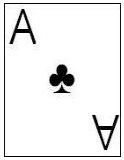 |
| Pair | This is a combination consisting of two cards of the exact same denomination. A pair can be beaten by a pair of cards of a higher denomination. | 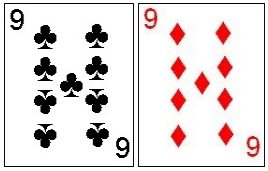 |
| Triplet | A Triplet is three cards of the exact same denomination. A specific Triplet can be beat by another Triplet of a higher denomination. | 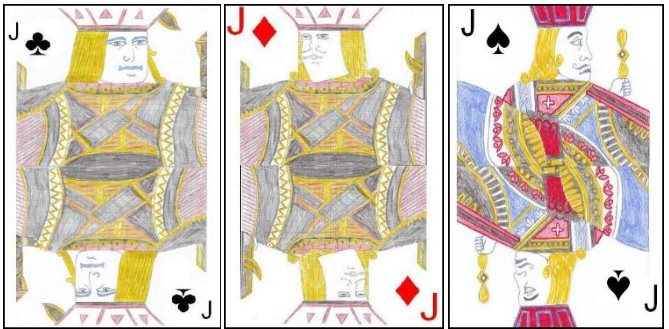 |
| Triplet with Kicker | This is a combination consisting of three cards of the same denomination and a fourth card of any other rank. A Triplet with Kicker can be beat by another Triplet with Kicker combination in which the rank of the Triplet cards is of a higher denomination. | 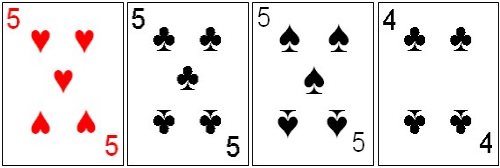 |
| Triplet with Pair | This combination consists of five cards, three cards of the same denomination and two other matching cards. A Triplet with Pair can be beat by another Triplet with Pair in which the Triplet consists of higher ranked cards than the first Triplet. |  |
| Sequence (Chain) | A Sequence is five or more cards in direct numerical sequence. The lowest allowable card in any sequence is a 3 and the highest is an Ace (Jokers and Twos are not permitted as part of a Sequence). A sequence meld can be beat by another sequence meld consisting of the same number of cards but in which the highest card in the sequence is of a higher denomination than that of the previous sequence. |  |
| Pair Sequence (Sisters) | A Sequence Pair consists of a minimum of at least three pairs of cards, with the denomination of each pair in direct sequence. A Sequence pair can be beaten by a similar sequence pair consisting of the same number of cards but in which the highest pair in the sequence is higher than that of the previous sequence. |  |
| Triplet Sequence (Airplane) | A Sequence Triplet consists of a minimum of at least two Triplets in which the cards of the two sets of triplets are in direct sequential order. A Sequence Triplet can be beaten by another Sequence Triplet consisting of the same number of cards but in which the highest ranked Triplet in the sequence is higher than that from the previous Sequence Triplet. | 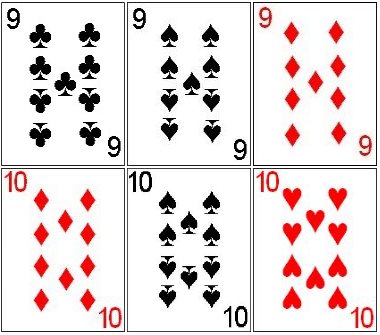 |
| Triplet Sequence with Kickers | A Triple Sequence with Kickers consists of a Triplet Sequence (as described above) with the addition of a number of odd, unmatched cards equal to the number of Triplets contained in the combination. These additional cards may not be of the same denomination as any other card in the Triplets Sequence with Kickers combination. A meld of this type can be beat by another Triplets Sequence with Kickers in which the highest Triplet in the sequence is higher than that of the previous such Triplets Sequence with Kickers. | 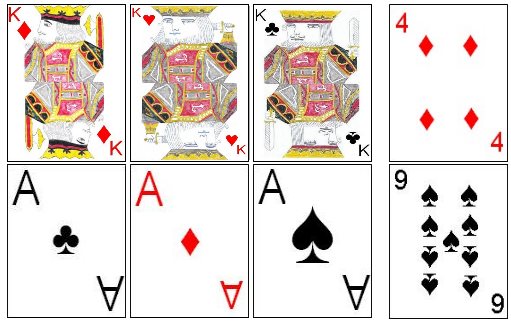 |
| Triplet Sequence with Pairs | The Triple Sequence with Pairs consists of a Triplet Sequence (as described above) with one additional Pair of cards added for each Triplet included in that Triplet Sequence. A combination of this type can be beat by another Triplet Sequence with Pairs in which the highest Triplet included in the sequence is higher than the previous such combination. | 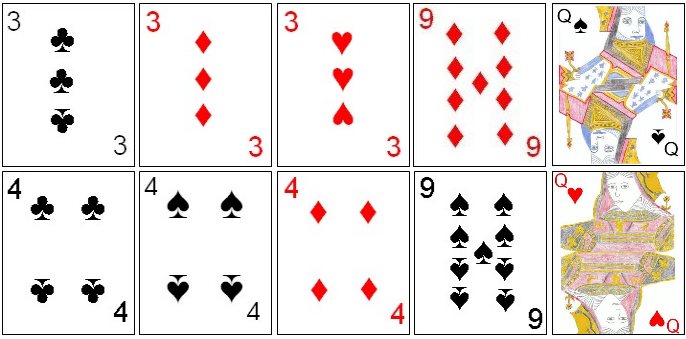 |
| Quad Set (Quadplex) with Kickers | A Quad Set with Kickers is a
combination consisting of four cards of the exact same denomination and two
additional cards included. Each of the two kicker cards must be distinct
from any other card comprising that same combination. A Quad Set with Kickers can be beat by another similar meld in which the four equally ranked cards are of a higher rank than that of the previous Quad Set with Kickers. | 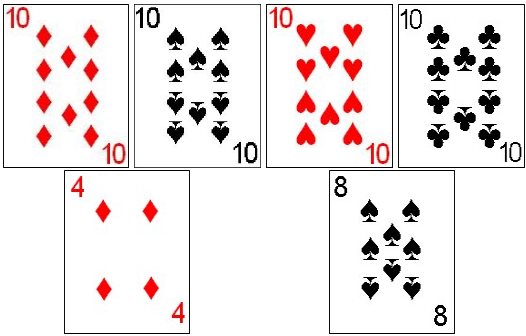
|
| Quad Set (Quadplex) with Pairs | A Quad Set with Pairs is a combination consisting of four cards of the exact same denomination and two additional pairs. A Quad Set with Pairs can be beaten by another Quad Set with Pairs in which the four equally ranked cards are of a higher denomination than that of the previous Quad Set with Pairs combination on this round. |  |
Kitty Cards: Some players slightly change the rules regarding the three card Kitty. In the standard version of the game as described above, the Landlord player must first show these three cards before adding them to his hand. In some games, however, the Landlord is not required to show these cards to the other players first, and simply adds them to his hand without exposing them to the other players.
Six Player Dou Di Zhu: There is also a unique six player variant of Dou Di Zhu which is sometimes played. This version is played by six players using three standard packs of cards including 2
distinct Jokers per pack. Each of the decks should have the same back design. The ranking of the cards is the same as in the standard three player variant as described above.
Determination of seating positions and the first player to draw cards is the same as in the standard variant. Similar to the standard version, one random card from the deck is faced and placed near the center of the large deck used for the game. As in the three player variant, the players then begin, one-by-one and in a counter-clockwise direction around the table, drawing the top card from the stock. This continues until each player has a total of 26 cards. The last remaining six cards from the deck are then placed face-down in the center of the table. Dissimilar to the standard game, there is no bidding for the right to be the Landlord for the hand. Instead, the player who received the face-up card becomes the first Landlord for the hand. This player will actually have a secret second Landlord player who will work in partnership (unknown at first to any of the other players, including the first Landlord) with the first Landlord to defeat the Farmers during the hand.
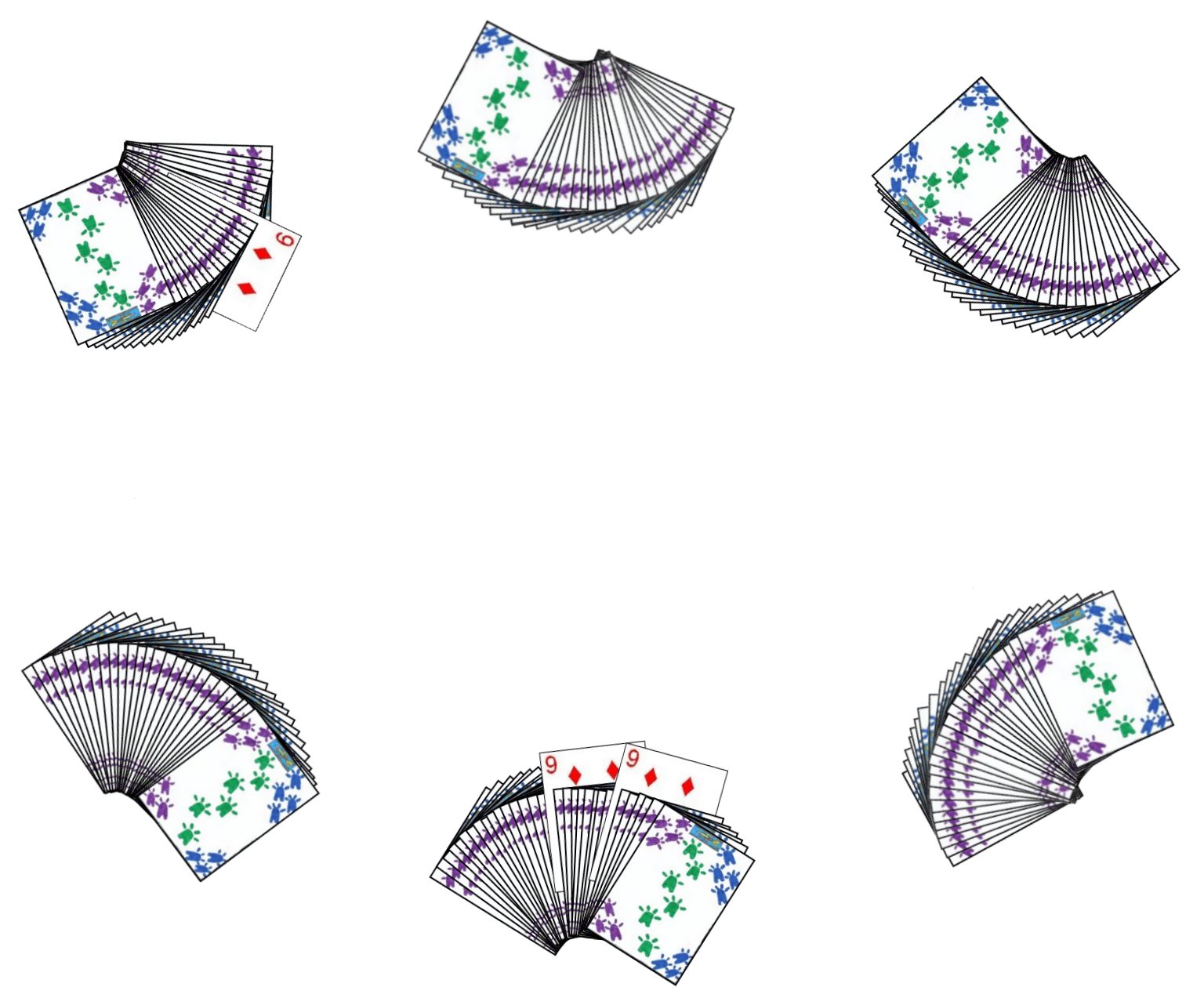
After all players have drawn the necessary cards, the Landlord player adds the six face-down cards from the center of the table into his own hand without showing them to the other players. The identified Landlord player will then examine his hand and publicly announce his highest pair of exactly identical cards. Although suits are normally not considered or important in this game, for this express purpose, for this purpose, this pair must be of the same suit and rank. After this announcement, whichever player has the third card of that same rank and suit becomes the second Landlord. He does not announce this fact but will attempt to assist the first landlord in winning the hand.
The hand itself is played identically to the three player variant, with the following differences:
- If any legal play is followed by five consecutive passes, the player who played the last combination has the privilege of starting the new round with any valid combination, played using cards remaining in his hand.
- If either of the Landlord players manages to play his last card from his hand, the Landlord team wins the game.
- The Farmer's team wins when two of the Farmer players manage to play the last of their cards.
- When the first Farmer player plays his last card, he drops from the game. The play continues with the other players attempting to beat that combination if able. If no other player is able (or chooses not to) beat that players last play, the player to the immediate right of the Farmer who dropped from the game begins the next round of plays, playing any combination from his hand.
- If either of the Landlords win the hand, both players on the Landlord team score one point. If two players from the Farmers team win the hand, all Farmer players earn one point.
In all other aspects, this version of the game is played identically to the standard variant as described above.
Four Player Dou Di Zhu: Dou Di Zhu is also sometimes played as a four player game, particularly in the Jiangsu and Zhejiang provinces in China. It is played identically to the more popular three handed variant with the following differences:
- This variant uses two standard decks, with each deck including two distinct Jokers. These decks should be of the same back design for the best game experience.
- The game consists of one Landlord competing against the other three players who attempt to defeat the Landlord.
- Determination of seating positions and the first player to receive cards is done identically to the standard variant. However, in this variant, the players continue to draw cards until each player has a total of 25 cards. The remaining eight cards from the deck are set face-down in the center of the table for the Landlord to take.
- As in the standard variant a bidding round occurs, with the high bidder set as the Landlord for the hand. This player adds the eight cards in the center of the table to his own hand without showing the cards to the other players.
- The single card combination type is not allowed, each combination must contain a minimum of two cards.
- If Jokers are used as part of a pair, the Jokers must be of the same type (i.e. both color Jokers or both black and white Jokers).
- The Quad Set with Kickers and Quad set with Pair combination types are not included and not used in this variant.
- A Bomb is a minimum of four cards of the same rank but may include more (up to eight). A bomb is the highest ranking combination which can be played in the game. It can only be beat by another, higher ranking bomb. In order to be considered a higher ranking bomb, a Bomb can either contain the same number of cards but be of a higher denomination or it can be a bomb (of any denomination) but consisting of more cards.
- A Rocket in this four player variant must consist of all four Jokers. As in the standard game, playing a Rocket doubles the scoring value for the current hand.
- The score for a hand is doubled for any Bomb played during the hand which consists of 6 or more total cards.
In all other aspects this game is played identically to the standard three player variant as described above.
Big Three: Big Three is another Chinese game in which the gameplay has some distinct resemblances to Dou Di Zhu. The game is known as Da San in Chinese, and also sometimes played under the name Dig a Hole.
Similar to Dou Di Zhu, Big Three is usually played by three players and is played using one standard 52 card deck. However the deck used for playing Big Three does not contain Jokers. The ranking of the cards used in Big Three are as follows (from high to low); 3, 2, Ace, King, Queen, Jack, 10, 9, 8, 7, 6, 5, 4.
To determine the first dealer, each player should draw one card from the shuffled deck. The player drawing the highest ranked number card in this deal is set as the first dealer. Specifically for purposes of this draw, Aces have a value of 1, 2 two, 3 three, 4 four and so on. Face cards have a value of 0. If multiple players draw cards with the same value, those players should discard that card and draw another card, continuing to draw until drawing a card of a rank in which no player has yet drawn. If seating positions at the table is also disputed, this can also be determined in the same way, with the players taking seats at the table in order from highest to lowest.
After the first dealer has been selected, this player should thoroughly shuffle the cards and offer the deck to the player at his immediate left to cut. After the cut, the dealer places the deck face-down in the middle of the table. As in most Chinese games, there is no actual deal but rather the players, in a counter-clockwise direction, starting with the dealer, each draw a card from the face-down deck and add it to his hand in a manner such that no other player can see his cards. This continues until each player has a hand of 16 total cards, which should leave four undrawn cards in the middle of the table. After each hand, the winner of the previous hand becomes the dealer for the next hand.
After the players have drawn the necessary number of cards, a bidding round begins. The player who has the four of Hearts card in his hand makes the first bid. If no player has this card (it being one of the four face-down undrawn cards), the player with the lowest card in the suit of Hearts starts the bidding. The first bidder, must make a bid of at least one, but may bid as high as 3. A player's bid is the number of points that may player can win or lose on the hand. After the first player's bid, the bidding continues in a counter-clockwise direction around the table. Each player must either Pass or make a bid higher than the current high bid. The bidding continues around the table until one player bids 3 (instantly winning the bid) or a bid is followed by two consecutive passes.
The player who made the highest bid is then set as the Player of the hand and plays against the other two players as his opponents. This Player then picks up the four face-down cards in the center of the table adding them to his own hand, but does not show any of his cards to his opponents.
After the auction, the player who had the first bid (whether he actually won the bidding or not) also has the first play. This player then may make any of several legal plays in the game. The following are the legal combinations in which this player can make:
| Combination Type | Description | Example Play |
|---|
| Single Card | This can be any single card of any rank or suit from the player's hand. In comparing two such single card combinations, the higher ranked is the card as per the card ranking of the cards as used for Big Three (see above). | 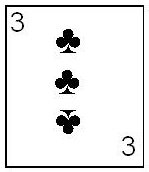 |
| Pair | This combination consists of two cards of the same rank. In comparing multiple pairs, the highest ranked is that in which the pair contains the highest ranked cards. | 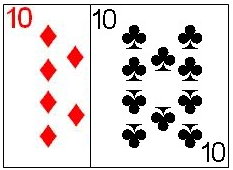 |
| Triple | This combination consists of three cards of the same rank. In comparing triplets, the highest ranked is that in which the triplet consists of the highest ranked cards. |  |
| Quad | This combination consists of all four cards in the same rank. In comparing multiple quads, the highest ranked is that in which the cards making up the quad contain the higher ranked cards. | 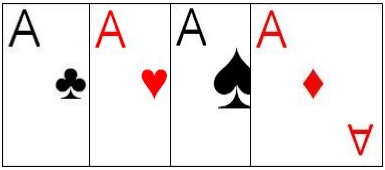 |
| Run | A run is a combination which consists of three or more cards all in direct
sequence, irregardless of suit. In comparing runs (which can only be compared with those consisting of the
exact same number of cards), the highest ranked run is that which has the highest ranked card within it. A run may never contain cards in the rank of 2, 3, or Ace. |  |
| Run of Pairs | This combination consists of two identical runs. Thus both runs with contain the exact same cards are be of the same length. The suit of the cards in the runs is irrelevant. In comparing multiple combinations of this type, the highest ranked is that which contains the highest ranked card within it. |  |
| Run of Triplets | This combination consists of three identical runs. Each run must contain the exact same ranked cards but the suit of the cards in the runs is irrelevant. In comparing multiple combinations of this type, the higher ranked is that which contains the highest ranked card within it. |  |
| Run of Quads | This combination consists of four identical runs. Each run must consist of the exact same ranking of cards, but the suits of the cards in each run is irrelevant. In comparing combinations of this type, the highest ranked is that in which the runs contain the highest cards. |  |
After the player plays his choice of any of these combination types, the
next player then attempts, if able and willing, to play a similar
combination, of the same type and consisting of the same number of cards
but which is higher ranked within that combination type. Thus, if the
first player were to play a pair of tens, the next player could play a higher such combination of two Kings to beat the prior player's combination. If a player is unable or unwilling to make a higher such play, he must pass and the turn would then advance to the next player in a counter-clockwise direction. This continues around the table with each player attempting to beat the previous player's combination, until two consecutive players pass.
Once two consecutive players pass, all the cards played during the
previous play are turned face-down and set aside, out of play for the
remainder of the hand. The last player who played (who would have played
the highest combination during this round) is then entitled to start any new legal combination of his choice.
The game continues in this manner until one player manages to play the last of his cards, winning the hand. Once this occurs, scoring of the hand occurs. If the high bidder managed to be this player to first run out of cards, he earns a certain number points for each opponent in the game. However, if one of the opponent manages to run out of cards before the high bidder managed to so run out, each opponent wins a number of points from the high bidder instead. The number of points earned or lost per opponent is equal to the amount of the high bidders high bid during the auction. After a set number of hands, the player with the highest grand total is declared the overall game winner.
Four Player Big Three: A variant of Big Three for four players is also sometimes played. It is played identically to standard Big Three with the following differences from that game:
- The entire desk is dealt out to the players, with each player receiving a hand consisting of 13 total cards.
- The bidding is conducted in the same manner as in the three player variant, however after the highest bidder is determined, this player names a card from rank four to ten that he currently does not hand (including the suit). Whichever other player has this card in hand becomes this player's partner for the game. However, this player should not announce this fact, and this will become known once that card appears during play of this hand. Thus, these two player play as partners against the other two players during this hand.
- Before a player is considered the highest card it must be followed by three consecutive passes. The player who had made that last player may then start a new set of
plays, leading any combination of his choice from his hand.
- As soon as any player manages to play his last card, that player and his partner (although he still has cards in hand), are announced the winners of the hand. Each of these players earn a number of Game points equal to the high bid on this hand, and each of the opposing players loses a number of Game points equal to the high bid on this hand.
In all other aspects the four player variant of Big Three is played identically to the more common three player variant as described above.
Copyright © 2015 CatsAtCards.com. All rights reserved.


























 After all players have drawn the necessary cards, the Landlord player adds the six face-down cards from the center of the table into his own hand without showing them to the other players. The identified Landlord player will then examine his hand and publicly announce his highest pair of exactly identical cards. Although suits are normally not considered or important in this game, for this express purpose, for this purpose, this pair must be of the same suit and rank. After this announcement, whichever player has the third card of that same rank and suit becomes the second Landlord. He does not announce this fact but will attempt to assist the first landlord in winning the hand.
After all players have drawn the necessary cards, the Landlord player adds the six face-down cards from the center of the table into his own hand without showing them to the other players. The identified Landlord player will then examine his hand and publicly announce his highest pair of exactly identical cards. Although suits are normally not considered or important in this game, for this express purpose, for this purpose, this pair must be of the same suit and rank. After this announcement, whichever player has the third card of that same rank and suit becomes the second Landlord. He does not announce this fact but will attempt to assist the first landlord in winning the hand.







